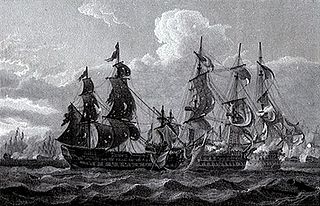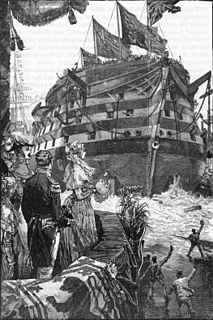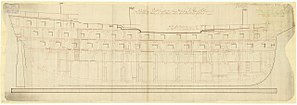
HMS Swiftsure was a 74-gun third-rate ship of the line of the Royal Navy, launched from Bucklers Hard on 23 July 1804.

Buckler's Hard is a hamlet on the banks of the Beaulieu River in the English county of Hampshire. With its Georgian cottages running down to the river, Buckler's Hard is part of the 9,000-acre (3,600-hectare) Beaulieu Estate. The hamlet is some 2.5 miles (4.0 km) south of the village of Beaulieu.

The Coventry-class frigates were 28-gun sixth rate frigates of the Royal Navy, principally in service during the Seven Years' War and the American Revolutionary War. They were designed in 1756 by Britain's Surveyor of the Navy, Sir Thomas Slade, and were largely modeled on HMS Tartar, which was regarded as an exemplar among small frigates due to its speed and maneuverability. The 1750s were a period of considerable experimentation in ship design, and Slade authorized individual builders to make "such alterations withinboard as may be judged necessary" in final construction.

The Canada-class ships of the line were a series of four 74-gun third rates designed for the Royal Navy by William Bateley. The name ship of the class was launched in 1765.

The Exeter-class ships of the line were a class of four 64-gun third rates, designed for the Royal Navy by William Bateley.

The Ardent-class ships of the line were a class of seven 64-gun third rates, designed for the Royal Navy by Sir Thomas Slade.

The Royal Oak-class ships of the line were a class of six 74-gun third rates, designed for the Royal Navy by Sir John Williams. The Alfred class were an enlarged version of the Royal Oak class.

The Ganges-class ships of the line were a class of six 74-gun third rates, designed for the Royal Navy by Sir Edward Hunt.

The Courageux-class ships of the line were a class of six 74-gun third rates of the Royal Navy. Their design was a direct copy of the French ship Courageux, captured in 1761 by HMS Bellona. This class of ship is sometimes referred to as the Leviathan class. A further two ships of the class were built to a slightly lengthened version of the Courageux draught. A final two ships were ordered to a third modification of the draught.

The Intrepid-class ships of the line were a class of fifteen 64-gun third rates, designed for the Royal Navy by Sir John Williams. His design, approved on 18 December 1765, was slightly smaller than Sir Thomas Slade's contemporary Worcester-class design of the same year, against which it was evaluated competitively. Following the prototype, four more ships were ordered in 1767–69, and a further ten between 1771 and 1779.

The Caledonia-class ships of the line were a class of nine 120-gun first rates, designed for the Royal Navy by Sir William Rule. A tenth ship was ordered on 29 October 1827 to the same design, but was launched in 1833 as Queen to a fresh design by Sir William Symonds.

The Fame-class ships of the line were a class of four 74-gun third rates, designed for the Royal Navy by Sir John Henslow. After the name-ship of the class was ordered in October 1799, the design was slightly altered before the next three ships were ordered in February 1800. A second batch of five ships was ordered in 1805 to a slightly further modified version of the original draught.

The Repulse-class ships of the line were a class of eleven 74-gun third rates, designed for the Royal Navy by Sir William Rule. The first three ships to this design were ordered in 1800, with a second batch of five following in 1805. The final three ships of the class were ordered towards the end of the Napoleonic War to a modified version of Rule's draught, using the new constructional system created by Sir Robert Seppings; all three were completed after the war's end.

The Canopus-class ships of the line were a class of nine 84-gun two-deck second rates of the Royal Navy. Their design was based on an enlarged version of the lines of the captured French ship Franklin, since commissioned in the Royal Navy as HMS Canopus, although this ship herself was not included as a member of the class. The earlier ships were initially ordered as 80-gun third rates, but this classification was altered by changes in the rating system in February 1817. This class of ships is sometimes referred to as the Formidable class.

The Vanguard-class ships of the line were a class of two-deck 80-gun second rates, designed for the Royal Navy by Sir William Symonds, of which nine were completed as sailing ships of the line, although another two of these were completed as steam warships.
The Mermaid-class frigates were a group of six 28-gun sailing frigates of the sixth rate designed in 1760 by Sir Thomas Slade, based on the scaled-down lines of HMS Aurora.

The Lively class were a successful class of sixteen British Royal Navy 38-gun sailing frigates.
The Conway class sailing sixth rates were a series of ten Royal Navy post ships built to an 1812 design by Sir William Rule. All ten were ordered on 18 January 1812, and nine of these were launched during 1814, at the end of the Napoleonic War; the last (Tees) was delayed and was launched in 1817.
The Apollo-class sailing frigates were a series of twenty-seven ships that the British Admiralty commissioned be built to a 1798 design by Sir William Rule. Twenty-five served in the Royal Navy during the Napoleonic Wars, two being launched too late.

The Roebuck-class ship was a class of twenty 44-gun sailing two-decker warships of the Royal Navy. The class carried two complete decks of guns, a lower battery of 18-pounders and an upper battery of 9-pounders. This battery enabled the vessel to deliver a broadside of 285 pounds. Most were constructed for service during the American Revolutionary War but continued to serve thereafter. By 1793 five were still on the active list. Ten were hospital ships, troopships or storeships. As troopships or storeships they had the guns on their lower deck removed. Many of the vessels in the class survived to take part in the Napoleonic Wars. In all, maritime incidents claimed five ships in the class and war claimed three.

















